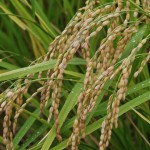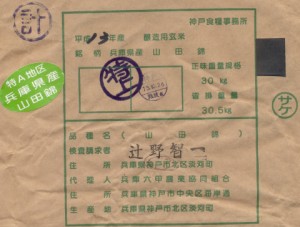 Rice is not, as most readers know, simply rice. Good sake is made from proper sake rice, and cheaper sake is made from much less expensive rice. In fact, most run of the mill average sake is made with rice bought from the local agricultural co-op, and often the purchaser knows nothing about it other than it came from within that prefecture.
Rice is not, as most readers know, simply rice. Good sake is made from proper sake rice, and cheaper sake is made from much less expensive rice. In fact, most run of the mill average sake is made with rice bought from the local agricultural co-op, and often the purchaser knows nothing about it other than it came from within that prefecture.
Among the 100 or so types (a few are added and subtracted each year) of officially designated sakamai, or sake rice, there are many differences that make each type more suited or less suited to sake brewing: size of the grains, starch content and location within the grain (if it is not centered, it cannot be milled properly!), and physical hardness are but a few of those considerations.
And even within one sakamai type, there are greater and lesser manifestations. Let’s look at some of these differences, as well as how they are measured and conveyed.
When the rice arrives at the sake brewery, it comes as genmai (unmilled, brown rice) in 30 kilogram brown paper bags.
 Stamped on each bag will be the name of the strain of rice, its prefecture of origin, and the inspected grade, which indicates which of the five classes of rice for which it passed inspection. The five grades are Tokujo (the best), Tokuto (the 2nd best), Itto, Nitto and Santo, in descending order. (The bag on the right shows Tokujo grade Yamada Nishiki rice, by the way, from a Special A designated field in Hyogo; this is as good as it gets!)
Stamped on each bag will be the name of the strain of rice, its prefecture of origin, and the inspected grade, which indicates which of the five classes of rice for which it passed inspection. The five grades are Tokujo (the best), Tokuto (the 2nd best), Itto, Nitto and Santo, in descending order. (The bag on the right shows Tokujo grade Yamada Nishiki rice, by the way, from a Special A designated field in Hyogo; this is as good as it gets!)
The differences between the various grades are characterized by things like size. And while the size of grains is indeed important, other things matter too, such as a lack of broken grains, and a lack of aomai, or grains that have not ripened and remain green. Size, by the way, is measured by the weight of 1000 grains.
Note, that just a bag of rice says tokujo does not mean that every grain in that bag is of tokujo class. There will always be a certain amount of smaller grains, cracked grains, and un-ripened grains as well. This is evidence of the fact that, within any one field, there will be greater and lesser grains, so to speak.
There is much, much more to the rice world than most of us are aware of, and the methods of quality control and selection for sake rice can be interesting.




